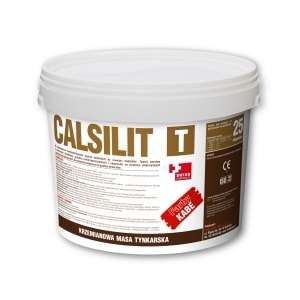CALSILIT T – Silicate render

It is used for applying manually thin top coats outside buildings and finish coats for KABE THERM SM and KABE THERM SM RENO* EWI systems based on EPS. It can be used only on mineral substrates (such as: concrete, cement mortar, lime or cement-lime mortars), on new and existing (retrofit) building walls, including also renovation of historical buildings. Thanks to high vapour permeability it allows for ‘free’ evaporation of moisture present in the masonry. The substrate should be primed with CALSILIT GT before applying the render.
* Using the material as a part of the insulation system, the manufacturer provides a guarantee only if all components of the KABE THERM SM or KABE THERM RENO systems are used.
| Base binder: | potassium water glass; |
| Pigments: | non-organic coloured pigments resistant to atmospheric conditions; |
| Colours: | natural white, colours from the KABE colour chart and selected NCS colours (can be obtained by adding non-organic pigments); |
| Textures: | solid/grained; |
| Grain size: | 1.0 mm; 1.5 mm; 2.0 mm; 2.5 mm; 3.0 mm; |
| Temperature of application (air and substrate): | from +8°C to +25°C; |
| Relative humidity: | ≤75%; |
| Vapour permeability: | Sd=0.06 m (cat. V1); |
| Water absorption: | W=0.49 kg/m2∙h0.5 (cat. W2); |
| Packaging: | Single-use plastic packaging of 25 kg. |
| Storage: | The product should be stored in its original sealed packaging in a cool frost-protected room. Opened packaging should be tightly closed and used as quickly as possible. |
| Shelf life: | Originally sealed products have a 12-month shelf life from the date of production (this is printed on the side of the packaging). |
• Mineral character
• Resistance to adverse atmospheric conditions
and industrial contamination
• High dirt resistance
• Exceptional vapour permeability
• Natural resistance to algae and fungal growth
SUBSTRATE PREPARATION: Apply to a mineral, sound/stable and clean substrate (without cracks and delaminations), degreased, even and dry, and biological or chemical efflorescence free. In case of algae/fungi growth, the substrate should be cleaned mechanically and then wash with water and disinfect with ALGIZID. Any loose layers not bound to the substrate (i.e. loose render or flaked coatings) should be removed. Old and/or dirty substrates should be washed off and degreased with water and CLEANFORCE cleaning agent. For uneven substrates, first use levelling compound and then level out the surface with finish levelling and smoothing compound. Small unevenness can be levelled out at once with finish levelling and smoothing compound. Use the above products according to their technical data sheets. Absorbent substrates should be primed before finish levelling and smoothing compounds and/or levelling compounds application. If the render is applied on new mineral substrates (i.e. concrete, cement render, cementlime render) – a min. 2-week curing period is required. All coats of EWI system should be applied in accordance with the requirements for external thermal insulation composite system (ETICS). Note: Directly before applying a silicate render, the surfaces made of materials susceptible to alkalis (i.e. wood, metal, glass or clinker brick) should be protected against splashing.
PRIMING: The substrate should be primed with CALSILIT GT before applying the render. Primer should be dry before applying a finish coat, curing period lasts about 24 hours. To reduce the risk of substrate colour showing through the texture of coating, it is recommended to use primer that is of the same colour as the render.
PRODUCT PREPARATION: The packaging contains a ready-to-use product. If stored for a long time and before application, the product should be thoroughly mixed with a low-speed mixer fitted with a basket stirrer until a smooth,
homogenous consistency is obtained. Further mixing is not recommended as it may result in excessive aeration of the product. If required, add a small amount of clean water (max. 0.25 l per 25 kg of the product). Quantity of added water may vary depending on the substrate type, drying conditions and application method.
APPLICATION METHOD: Using a stainless steel trowel, apply a thin, uniformed quantity of the product to the substrate. The thickness of the coat should be equal to the grain size. To create texture rub the surface with a plastic trowel with circular motions. Note: The product is alkaline, therefore, it is necessary to protect eyes and skin. Safety clothing (PPE) must be worn while carrying out any installation work. In case of contact with eyes, immediately rinse them thoroughly with plenty of water. If irritation develops, seek medical assistance.
DRYING: Typical binding (setting) time ca. 72 h (20°C, 55% RH). Note: Setting time may be longer even up to a few days due to low temperatures and high relative humidity. Protect the fresh render against precipitation and condensation until complete setting and binding is obtained.
USEFUL HINTS: The final effect may be determined by the substrate type. This is why if non-uniform substrate is present, it is recommended to prior level out and smoothen the whole substrate with levelling compound. To avoid colour differences, a single batch product should be used on a single application / architectural element. ‘Wet on wet’ method should be used. All tools should be cleaned with water after work is completed. Application and binding of render requires dry days and the temperature within a range from +8°C to +25°C. Avoid working on surfaces directly exposed to sun and strong winds. To protect the fresh coat against inclement weather conditions, scaffolding should be covered with protective nettings and tarpaulins. Note: Low or high temperature as well as high humidity may have a disadvantageous impact on the shade of the top coat. Both, too high and too low temperature while render application and setting may lead to insufficient setting of the binder. As a result of it, further contact with water may cause washing out of the unset potassium water glass what may lead to the formation of durable patches or discolouration.

 CALSILIT T - TDS
CALSILIT T - TDS